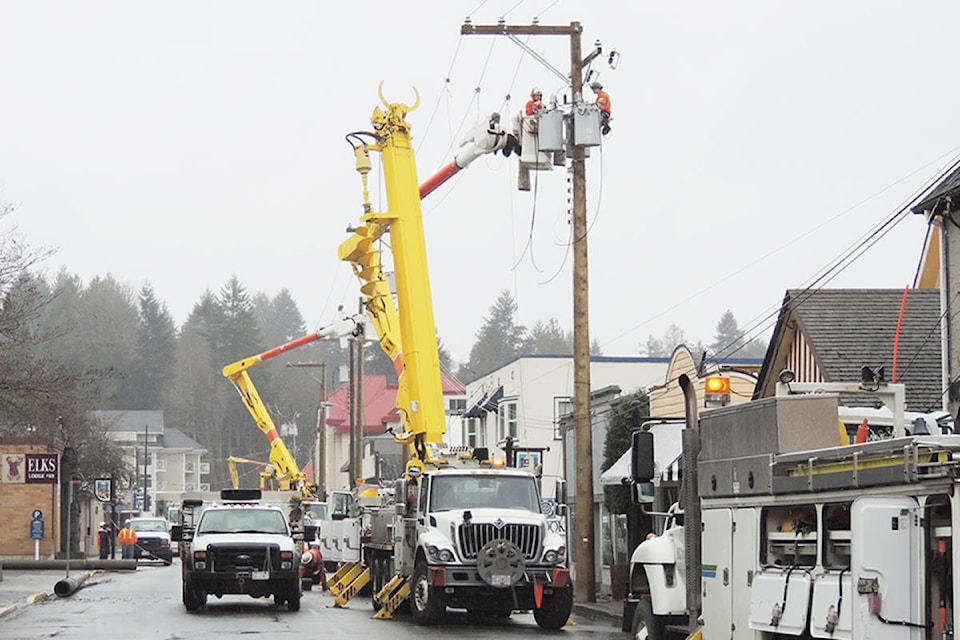When we kids scrambled into the holes to salvage the wires snaking in, under and around the broken rock-fill, we literally were playing Russian roulette.
We’re moving past the dog days of summer, with all the ads for back to school supplies, etc., which always used to depress me as a student.
All these years later, they never fail to set me to looking back to memories past…
Coincidentally, while filing a batch of newspaper clippings, I found an odd vignette that rekindled thoughts of my childhood. It was recently reported that after well over a century — since the invention of the telegraph — wooden power poles are on the way out, at least here in B.C..
Would you believe that there are about 130 million standing poles throughout North America? B.C. Hydro alone has a grid spanning nothing less than 58,000 kilometres of overhead distribution lines! Each costs as much as $5,000 to install, by the way.
And the oldest pole yet in service? It’s a hoary 81 years old, and in Port Renfrew, just one of Hydro’s 900,000 poles province-wide. Of these, an average 8,400 require replacing annually, even native red cedar rarely lasting 25 years if untreated.
Besides each pole being recorded in a master registry at head office, each one is physically dated; just look for a small metal plate about five feet or so from the ground and you’ll find a code including the year of planting.
Which is where my memory kicked in. I can still see in my mind’s eye as B.C. Telephone (pre-Telus) linemen installed new poles (telephone not power) on my street in Saanich.
This was so long ago (it hurts me to admit it) that it was before the advent of mechanized post hole diggers. In other words, the crew of four dug each hole with shovels. (Even with today’s technology it still takes a crew of four.) Why what might strike you as a rather mundane act sticks in my mind is how they managed to excavate such a deep hole, at least four feet, while keeping the diameter just large enough to accept the pole.
This was well below the clay level you understand; anyone who has ever dug a fence post hole knows that, usually, the deeper you go the harder it gets. And they wanted to keep the hole as tight as possible so that the newly-installed pole wouldn’t lean.
But, in that golden age before the power auger, their answer, once the hole got so deep that they couldn’t comfortably proceed with ordinary shovels, was what looked to be a huge spoon at the end of a long handle. They’d twist and rock this back and forth, breaking through the clay inches at a time and periodically removing the soil until they achieved the desired depth.
If that all sounds no-big-deal to today’s readers who enjoy all the benefits of a truly mechanized world, it was anything but to a kid. When I see today’s heavy equipment in operation it always reminds me of my favourite’s loggers’ term for a shovel: goon spoon!
Speaking of childhood memories of watching workmen, I sometimes think I and my neighbourhood chums were indeed lucky; not just in being able to eyeball what were to us fascinating construction projects up-front, but because of the opportunities for on-site explorations after quitting time.
There was no throwing up a portable fence in those days and, even if they had thought of it, when a municipal road crew was laying a pipeline along Saanich Road they had to blast their way through bedrock for hundreds of feet, particularly in the several blocks between Darwin and Vernon roads.
The practice then, as now, was to expose the bedrock, drill a series of holes, insert the explosive, prime it with electric detonators (copper tubes about the length and diameter of a stubby cigarette). These were connected by cable to a plunge-type detonator after the charges had been shrouded with blasting mats (basket-weaved of strips of used tires, or, sometimes, a boom of logs.
That done, they’d clear the site, fire the charge, wait for the smoke and fumes to clear then remove the mats and the loose rock, and repeat the process as necessary.
What this meant to us kids besides the thrill of ka-booms! was the chance, after the workers went home, to salvage the thin red and yellow blasting wire which we’d braid into various useful items. I remember using it to repair my hunting knife sheath when the thread rotted.
The point of my story is, it’s common knowledge that not all detonators work on command and not all explosive charges go off as ordered. When we kids scrambled into the holes to salvage the wires snaking in, under and around the broken rock-fill, we literally were playing Russian roulette. Upon spotting a tempting few feet of wires (always in pairs) we’d simply grab hold and give a good yank; either it came free or it broke off and we’d have to try again.
What better way to ignite a mis-fired detonator and the sticks of dynamite to which it was wired than that? You can bet that no construction site would ever allow kids’ access to such hazardous playgrounds today.
Well, those days are long gone in fact if not from my memory bank…
